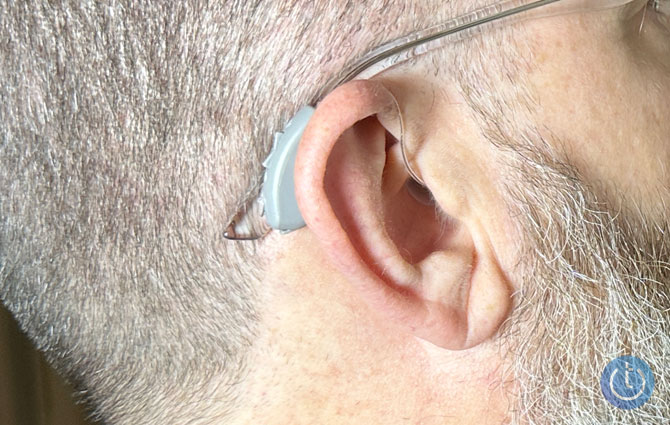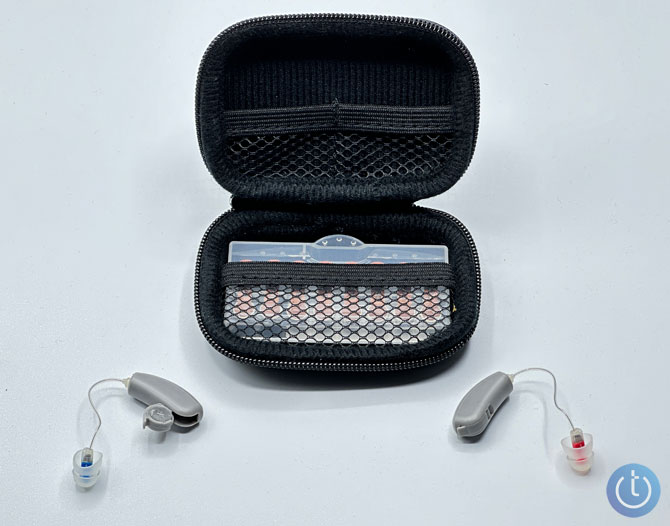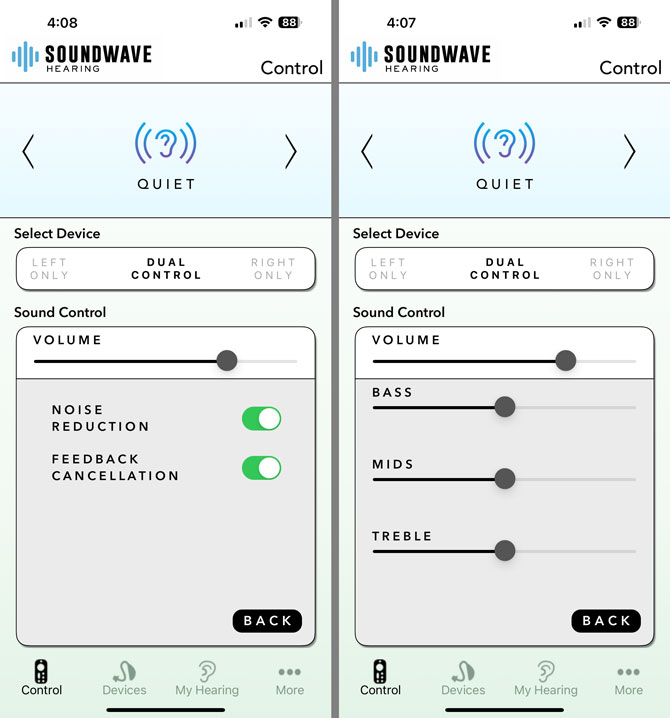We may earn commissions when you buy from links on our site. Why you can trust us.
Soundwave Sontro OTC Hearing Aids: Average Performance, Decent Price
After testing a large bulk of the available OTC hearing aids over the last year plus, I believe models powered by single-use batteries are, well, stupid, especially with the wealth of rechargeable alternatives now available. Tiny hearing aid batteries are awkward to swap, and the ongoing replacement cost soon makes up for any savings in the original device price. It’s hard to imagine many OTC hearing aid vendors continuing to make or sell single-use battery models for very long.

Trying to stay objective in the face of my admitted single-cell prejudice, the Soundwave Sontro receiver-in-canal (RIC) style self-fitting OTC hearing aids ($749) are perhaps the last of a dying breed. Like other RIC hearing aids, the Sontro store their batteries in packs that sit behind the ear; in Sontro’s case, standard #312 1.45-volt hearing aid batteries you can find in any drugstore. As a result, the Sontro are slightly less expensive than rechargeable RIC competitors, such as the similarly self-fitting RIC Lexie B2 Powered by Bose ($999, currently discounted to $899). In the small single-use battery self-fitting OTC hearing aid product universe, however, Sontro has only one true competitor, the in-ear bud Sony CRE-C10 ($999, also currently discounted to $899).
Like the Sony C10, the Sontro uses only Bluetooth Low Energy (BLE) for connection to its app – no music streaming or hands-free phone calls. The Sony C10, of course, offers an additional aesthetic advantage: it’s an in-ear bud that is nearly invisible. Ultimately, your purchase choice will largely depend on your convenience, aesthetic, and budget considerations.
| + Pros | – Cons |
|
|
What's in the box
Inside the Sontro box is a four-pack of Rayovac Extra 312 batteries to power your first week of ownership. Also included are five sets of dome tips: the pre-installed domes are medium open, which can be swapped out for small open, small “power,” large open, or double-flanged “tulip” domes. The larger “power” or “tulip” domes are designed to diminish potential feedback. You can buy replacement domes in packs of ten ($19) on the Soundwave site.
Also included are two “sport locks,” essentially small plastic ties, which keep the behind-the-ear receiver module and the speaker dome more firmly in place when exercising. A receiver measurement tool is included in case you’ve got a big head and need a longer connecting receiver wire ($49). Also in the box is a pair of standard Cerustop wax guards and a cleaning/wax guard replacement tool. Replacement wax guards (32 pieces, $14) can be purchased on Amazon. Finally, there is a reasonably compact 3.75 x 2.75 x 1.25-inch zippered carrying case with netted compartments to hold the hearing aids and spare batteries.

Setup
As with all self-fitting buds, Soundwave’s otoTune smartphone app includes a self-administered hearing test, which can be completed in three minutes or so in a quiet room. The app lets you retake the test if needed and keeps track of previous test results.
The app has three primary ambient settings: Automatic, Quiet, and Noise. The latter two include a three-band slide equalizer (bass, mids, treble) and Settings with on-off toggles for noise reduction and feedback cancellation – although, why would anyone NOT want these two features on?

You can set and control volume for both left and right simultaneously or individually. Under the Devices icon, you can see how much battery life remains in each receiver bud.
Audio performance
Once the results of the app hearing test were applied, the Sontro did a good job of un-muddying my hearing to provide crisper, clearer sounds, especially voices. However, the improvement was not quite as audibly startling, crystalline, or as loud as the clarity and volume improvement I got from the Sony C10 or other self-fitting RICs I’ve tested, such as the Orka 2 or the Sennheiser All-Day Clear, which are, admittedly, around twice the price of the Sontro. Also, it takes about 30-60 seconds once you close the battery cover for the receivers to power up, kick into aural clarifying gear, and connect to the otoTune app.
Once powered and operating, some higher-pitched sounds periodically produced short-sharp whistling feedback squeals, endemic with many RIC-style hearing aids. It took a good deal of trial-and-error futzing with the app volume and EQ settings and dome swapping to alleviate, but not completely eliminate, the occasional squealing.
For instance, lowering the treble in the Quiet and Noise modes helped alleviate the feedback. However, this is a case of the cure being worse than the disease; lowering the treble drastically reduces voice clarity, defeating the Sontro’s purpose.
Switching from the “open” to the “power” and then finally to the “tulip” domes also helped to reduce the squeals while being able to maintain acceptable treble levels. Surprisingly, the double-flanged “tulip” dome did not completely clog or seal my ear canal – I still experienced a semblance of open ambient soundscape compared to ear-sealing buds.
Some of the feedback squeal I experienced would no doubt be alleviated by the longer – and unfortunately not included – receiver wire. While the Sontro’s receiver wire is the same length as those on the Lexie B2 and Elehear Alpha Pro, both of which also gave me minor feedback problems, it’s about a fifth of an inch shorter than the Sennheiser All-Day Clear and the Orka 2, both of which gave me far fewer feedback problems. A fifth of an inch may not sound like a lot, but since feedback is caused by microphone-to-speaker proximity, that fifth of an inch moves the receiver module, which houses the microphones, a smidge further behind your ear and would seem to reduce feedback significantly.
I really couldn’t detect much difference in the sound with Noise Reduction toggled on or off. Both ways, I often annoyingly and unnecessarily heard boosted incidental sounds such as light switch flipping, creaking floorboards, running water faucets, and keyboard key clacking.
As far as the pre-sets are concerned, “Quiet” slightly increased the middle frequencies, including voices, and “Noise” suppressed some additional noise missed by the Settings’ Noise Reduction toggle and increased treble to make voices sound sharper and slightly shriller. You get a barely audible voice confirmation as you switch modes.
I also physically “felt” the Sontro after a few hours of wear. One reason may be that the receiver module is slightly bulkier than the modules on the Sennheiser All-Day Clear. The Sontro don’t necessarily become uncomfortable, though some might say they do, but I didn’t forget I was wearing them as I often did with other in-ear and RIC models I’ve tested. Also, the Sontro’s behind-the-ear receiver modules seemed to audibly clink against the back of my glasses more than other RIC hearing aids I’ve tested. However, the clinking is barely noticeable; I only noticed it because I always listen for it when testing RIC hearing aids.
Battery pros and cons
OTC hearing aids powered by single-use batteries, such as the Sontro and the Sony CRE-C10, present sharp pros and cons.
On the pro side, the Sontro are cheaper than their rechargeable competitors; they are $250 less than the rechargeable Lexie B2 and Alpha Pro and about half the price of the Orka 2 and Sennheiser All-Day Clear. Sontro’s single-use batteries can last around four 16-hour days, assuming you remember to open the battery compartment to turn them off before you go to bed, compared to the 12 to 16-hour lifespan of rechargeable models that require nightly recharging. And with single-cell batteries, you’ll always get full battery life; rechargeable lithium batteries eventually lose 10-20% of their power capacity after a year or so.
On the con side of single-use batteries, you have to carry spare batteries with you just in case your batteries unexpectedly die. Else, you’ll have to suddenly hunt for a retail location that sells them. The pinhead-sized batteries can be awkward to swap out – I can’t tell you how often I’ve dropped one and was forced to grab a flashlight and get on my hands and knees to find it. It’s even more embarrassing if you’re on the street and worse if you drop a battery in your car and it rolls God-knows-where.
Another problem, unique to Sontro, is the fact that the battery readings in the otoTune app are hard to trust. For instance, when the left battery died, the app said the right battery still had 95% power remaining, which made no sense. A few minutes later, despite showing 95% battery life, the right battery died. After replacing the batteries using them for a full day, the app illogically told me I had 99% power remaining in each battery. After two days, though, the meters read a more accurate 50% remaining power. At the end of their life, you get a faint low-power alert just as the cell dies.
Finally, there’s the ongoing cost. Single-use batteries will cost you around $50-$60 a year; in anywhere from three to five years, the cost of buying single-cell replacement batteries could even out any original device purchase savings.
The bottom line
If you want the longer battery life single-use batteries provide, I recommend the Sony CRE-C10 instead of the Soundwave Sontro ($749), especially if you can buy the Sony at its $899 sale price. The C10 provide a bit more volume, rarely squeal, and are nearly invisible because they’re in-ear buds and have no behind-the-ear module to clink against your glasses.
If you're looking to spend less than $899 for the Sony CRE-C10, your choices come with compromises. If you want single-use batteries, the Sontro is the best choice. Otherwise, I'd recommend the Elehear Alpha Pro ($999, currently on sale for $499). The Elehear have the same RIC design and add music and hands-free calling, but they aren't self-fitting. As I said, you can't have it all at this price, so the best OTC hearing aids are the ones that prioritize what's important to you.
[Image credit: Stewart Wolpin/Techlicious]
Stewart Wolpin has been writing about consumer electronics for more than 35 years, including news, reviews, analysis and history, and has attended and covered nearly 50 Consumer Electronic Shows and around a dozen IFA shows in Berlin. For the Consumer Technology Association (CTA), he is an elector for and writes the official biographies of the annual CT Hall of Fame inductees, and is the keeper of the industry’s official history.














